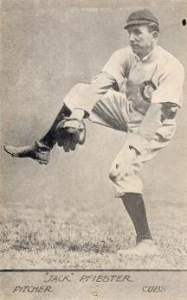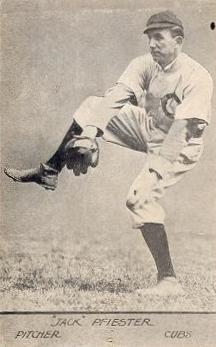Jack Pfiester
 A side-wheeling left-hander with a great pick-off move to first base that kept runners close, Jack Pfiester posted a lifetime 2.02 ERA over eight seasons, the third best of all-time for pitchers with at least 1,000 innings, but he is best remembered for his seven shutouts and 15-5 career record against the hated New York Giants. “No longer will Chicago’s fans struggle with the pretzel curves of the great southpaw’s patronymic; no longer will it be mispronounced by seven out of every eight bugs and bugettes,” wrote I. E. Sanborn of the Chicago Tribune after Pfiester’s 2-1 victory over the Giants on August 30, 1908. “Pfiester, the spelling of which has been the occasion of as many wagers as its mispronunciation, will be dropped as meaningless and inappropriate, and for the rest of time and part of eternity Mr. Pfiester of private life will be known to the public and the historians as Jack the Giant Killer.”
A side-wheeling left-hander with a great pick-off move to first base that kept runners close, Jack Pfiester posted a lifetime 2.02 ERA over eight seasons, the third best of all-time for pitchers with at least 1,000 innings, but he is best remembered for his seven shutouts and 15-5 career record against the hated New York Giants. “No longer will Chicago’s fans struggle with the pretzel curves of the great southpaw’s patronymic; no longer will it be mispronounced by seven out of every eight bugs and bugettes,” wrote I. E. Sanborn of the Chicago Tribune after Pfiester’s 2-1 victory over the Giants on August 30, 1908. “Pfiester, the spelling of which has been the occasion of as many wagers as its mispronunciation, will be dropped as meaningless and inappropriate, and for the rest of time and part of eternity Mr. Pfiester of private life will be known to the public and the historians as Jack the Giant Killer.”
The son of Theodore and Margaret (Lynn) Hagenbush, John Albert Hagenbush was born in Cincinnati on May 24, 1878. Jack’s early life was tragic. His father and mother both died in 1881, and his aunt and uncle, Fred Pfiester, took care of him and lent him their surname.
In addition to his work in a wholesale leather house, Jack pitched for semipro teams around Cincinnati, jumping directly from the Shamrocks to the American League’s Baltimore Orioles in 1901, though he failed to appear in an official game. In 1902 he pitched the entire season for Spokane of the Pacific Northwest League, ending up at 13-15. The next year Pfiester went 19-16 and struck out 195 in 288 innings for San Francisco of the Pacific Coast League, earning a late-season tryout with the Pittsburgh Pirates. Making his major-league debut on September 8, 1903, the 25-year-old southpaw lost all three games that he pitched for the Pirates, striking out 15 but compiling a 6.16 ERA and giving up 26 hits and 10 walks in 19 innings pitched. Pfiester was even worse in three games with Pittsburgh in 1904; his ERA was 7.20 and he gave up 28 hits and nine walks in 20 innings, this time striking out only six. The Pirates farmed him out to Omaha of the Western League, where one of his teammates was Mordecai Brown.
Pfiester developed into a top-notch pitcher at Omaha, leading the league with 178 strikeouts in 1904 and compiling a combined record of 49-22 in 1904-05. After his purchase by the Chicago Cubs, Jack entered the record books on May 30, 1906, by striking out 17 batters in 15 innings, setting a modern National League mark that stood until Warren Spahn struck out 18 on June 19, 1952. Pfiester went on to complete one of the finest rookie campaigns in history, ranking second in the NL in ERA (1.51) and fewest hits per game (6.21), fourth in strikeouts (153), fifth in winning percentage (.714), and sixth in wins (20). In that year’s World Series, however, he was the losing pitcher in both of his appearances against the cross-town White Sox. Pfiester started and lost Game Three to Ed Walsh, 3-0, despite giving up only four hits and striking out nine. He also lost Game Five, giving up three hits and four runs in one inning of relief. Pfiester’s regular season success continued into 1907, when he posted a 14-9 record and led the NL with a 1.15 ERA, the sixth lowest single-season ERA in the history of baseball. Again he placed second in fewest hits per game (6.60). This time the Cubs won the World Series, and Jack gained the victory in Game Two, 3-1, by scattering nine Detroit Tiger hits.
Pfiester put together another solid season in 1908, going 12-10 with a 2.00 ERA while developing his “Giant Killer” reputation. He is best remembered as the Cubs pitcher in the famous “Merkle Game” on September 23, avoiding a 2-1 loss only because Fred Merkle failed to touch second base, but what few people realize is the extent of the pain with which he was pitching. Teammate Johnny Evers wrote that “a lump had formed on his forearm, the muscle bunching. He could not bend his arm, and to pitch a curve brought agony.” According to Evers, Pfiester threw only three curveballs the entire game, all to Mike Donlin in clutch situations, and had to be helped to the bench after each curve. Immediately after the game, Jack traveled to Youngstown, Ohio, to be treated by Bonesetter Reese. “Reese felt around, located the dislocated tendon, and snapped it back in place with his powerful fingers,” wrote sportswriter Charles Dryden. “The entire diagnosis and cure occupied less than 10 minutes. Think of it, constant readers, Mr. Pfiester pitched nine full innings with a dislocated arm and held the Giants to five hits! Had Jack’s neck been broken he would have shut them out.”
Pfiester’s performance after returning to the Cubs indicates that he might not have been cured by his visit with Reese. He started the one-game playoff against the Giants on October 8 but was knocked out in the first inning. Four days later Jack started and lost Game Three of the World Series (the Cubs’ only defeat), giving up 10 Tiger hits and seven earned runs in eight innings. The 1909 season proved to be Pfiester’s last hurrah; he compiled a 2.43 ERA and went 17-6 to finish fourth in the NL in winning percentage. He missed most of 1910, ending up at 6-3 with a 1.80 ERA in only 14 games. That year Jack made his final appearance in the World Series, again pitching in Game Three and yielding nine Philadelphia hits in 6⅔ scoreless innings of relief. At spring training in 1911, Pfiester suffered from stomach trouble and for a time thought his heart was weak. He pitched in only six games for the Cubs that season, posting a 1-4 record and 4.01 ERA. Ironically, Pfiester’s last major-league game was against the Giants. He lasted only 2⅓ innings, giving up six hits and six runs-an uncharacteristic performance indeed.
Pfiester cleared waivers and the Cubs sent him to Louisville in a deal for pitcher Reggie Richter. Jack went 7-12 for the Colonels over the rest of the 1911 season, giving up 175 hits in 150 innings. Early the following year Chicago recalled him so they could sell him to Milwaukee, but the 33-year-old pitcher elected to retire instead. The full story of what happened didn’t come out until three years later when Pfiester filed a lawsuit against the Western Union Telegraph Company. Jack claimed that on May 3, 1912, a telegram from the Milwaukee club reading, “Will give you $300 per month,” and signed “Hugh Duffy,” was sent but not delivered. He claimed over $2,500 in damages as a result of his failure to secure that “profitable engagement.” Pfiester won the case and was awarded $2,000.
The 38-year-old southpaw returned to baseball with Sioux City of the Western League in 1916 but went 0-4 with a 4.17 ERA and received his unconditional release on July 13.
With his playing career now at an end, Jack and his wife, Lulu, whom he had married in 1903, settled north of Cincinnati in a village called Twightwee, near Loveland, Ohio. The couple had one son, Jack Jr., but the legal names of both Jack and his son were still John Albert Hagenbush and John Albert Hagenbush Jr., until Jack had them officially changed to Pfiester in 1950. Jack Pfiester died at age 75 on September 3, 1953, of a blood ailment that had earlier caused his left leg to be amputated above the knee.
NOTE: An earlier version of this biography appeared in Tom Simon, ed., Deadball Stars of the National League (Washington, D. C.: Brassey’s Inc., 2004).
Sources
In preparing this work, I made use primarily of Jack Pfiester’s file at the National Baseball Hall of Fame Library.
Full Name
John Albert Pfiester
Born
May 24, 1878 at Cincinnati, OH (USA)
Died
September 3, 1953 at Loveland, OH (USA)
If you can help us improve this player’s biography, contact us.


